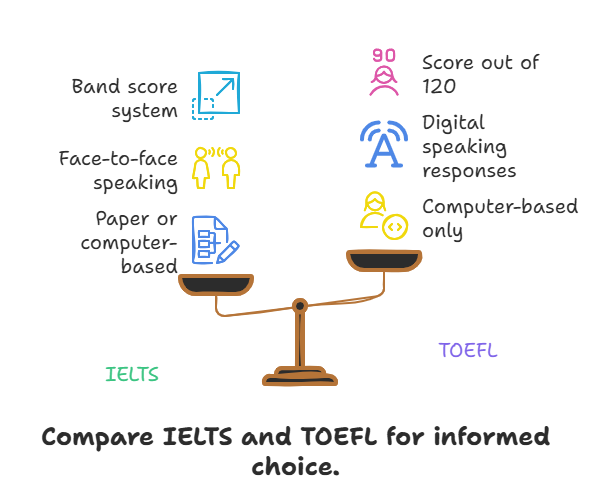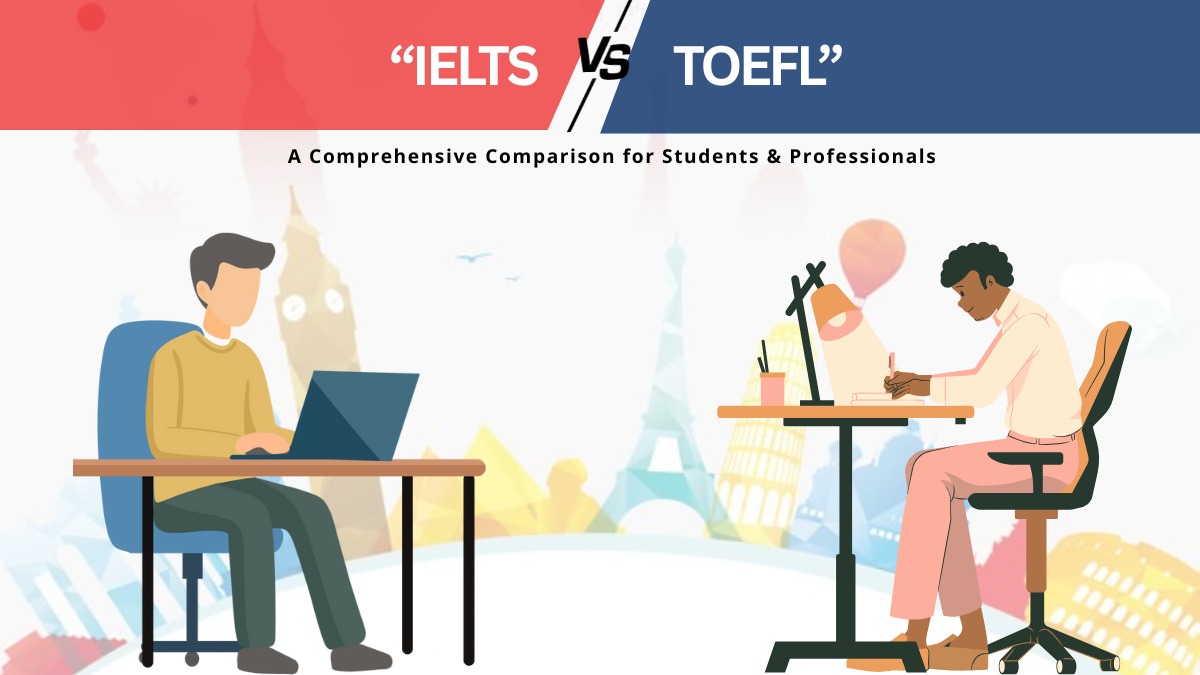Whether you are planning to study, work or immigrate to an English-speaking country, two of the most widely accepted examinations that are needed to prove your English proficiency are the International English Language Testing System or IELTS and the Test of English as a Foreign Language or TOEFL. But which test is the one for you? If you’re deciding between IELTS vs. TOEFL, it’s crucial to understand their differences. These tests assess your English skills but vary in format, scoring, and acceptance Let’s find out!
IELTS vs. TOEFL: Understanding the Key Differences
While IELTS and TOEFL are both tests that measure your expertise in the English Language, they are different in format, structure and scoring.
- IELTS is available in both paper-based and computer-based formats, whereas TOEFL is primarily computer-based.
- The IELTS speaking exam requires candidates to sit for a one-on-one interview with an examiner, while TOEFL asks to digitally record candidates’ responses.
- IELTS scores are evaluated using a 9-band scale, on the other hand, TOEFL scores you out of 120.
- The time limit for IELTS is approximately 2 hours and 45 minutes, while TOEFL extends to around 3 hours and 30 minutes.
- In terms of content, IELTS tests for both general and academic English, however TOEFL is more focused on academic English.
- IELTS is widely recognized in the UK, Canada, Australia and the United States whereas TOEFL is primarily required for United States institutions but is also accepted worldwide.

Here’s a concise overview of the key differences between IELTS and TOEFL:
| Structure | IELTS | TOEFL |
| Test Format | Paper or computer based | Computer based |
| Sections | Listening, Reading, Writing, Speaking | Listening, Reading, Writing, Speaking |
| Speaking Section | Face-to-face interview with an examiner | Responses recorded on a digital platform |
| Scoring System | Band score (0-9) | Score out of 120 |
| Duration | Approximately 2 hours 45 minutes | Approximately 3 hours 30 minutes |
| Availability | Over 140 Countries | Available in most countries |
| Accepted in | United Kingdom, Canada, Australia, USA among others | Primarily USA but also accepted globally |
IELTS or TOEFL? Selecting the Test that Meets Your Requirements.
When it comes to choosing between IELTS and TOEFL, the main thing to consider is which test prioritizes the aspects that you excel at. If you’re confident with direct human interaction, IELTS is the way to go as it includes a face-to-face interview with an examiner. On the contrary, if you perform better virtually, TOEFL may be the better option as all sections, including speaking, are conducted through a digital platform.
IELTS vs. TOEFL: Test Preferences Across Countries
Universities in the United States traditionally prefer TOEFL, however,an increasing number of U.S institutions have now started accepting IELTS as well. IELTS is accepted and available in most countries, whereas TOEFL is primarily recognized in the United States, Canada, United Kingdom, Australia, New Zealand and Europe. Both IELTS and TOEFL are accepted globally, but the preference varies by country and institution. Make sure that you check with your target university and immigration authority so that you can adhere to their requirements.
IELTS vs TOEFL: A Section-by-Section Breakdown
| Section | IELTS | TOEFL |
| Listening | Includes four sections, namely British, Australian, American and Canadian | Includes academic-style lectures and conversations, primarily in American English. |
| Reading | Consists of texts from books, newspapers and magazines. | Features university-level academic passages. |
| Writing | Requires a short essay and an analysis of a graph or diagram. | Requires an integrated task based on a passage and a lecture with an essay. |
| Speaking | Conducted in-person in front of an examiner | Responses are recorded and graded by both human examiners and A.I. systems. |
Preparation: IELTS vs. TOEFL
IELTS:
- Practice understanding different English accents while prioritizing American, British, Australian and Canadian.
- Perfect the art of writing essays and how to interpret various kinds of data.
- Work on refining interview responses and focus on not faltering as you will be required to have a face-to-face conversation with the examiner.
TOEFL:
- Get used to taking notes while attending academic lectures
- Practice typing faster for the writing section and time yourself for effective time management
- Rehearse speaking in front of a microphone to get used to the test environment.
IELTS vs. TOEFL: Exam Cost Comparison
The costs of the IELTS and TOEFL examinations vary depending on the country in which you take them. Below is a comparison of their fees in the most popular countries:
| Country | IELTS Fee | TOEFL Fee |
| United States | $245-$255 | $225 |
| Canada | CAD 319 | CAD 245 – CAD 330 |
| United Kingdom | £165 – £195 | £180 – £230 |
| India | INR 16,250 | INR 16,900 |
| Australia | AUD 340 – AUD 395 | AUD 300 – AUD 375 |
| Germany | $273 | $265 |
| France | $277 | $270 |
| Brazil | $245 | $240 |
| Indonesia | $204 | $210 |
| Mexico | $239 | $250 |
Note: These prices are an approximate estimate and are subject to change. Keep checking the official websites for updated prices.
Both IELTS and TOEFL are widely accepted worldwide, however the choice between the two resides in your hands. You should choose whichever test aligns with what you excel at while also keeping in mind what the requirements are for the country and University that you are planning to apply for. To determine which test is easier for you, you need to first figure out your strengths. IELTS covers both general and academic topics while TOEFL focuses only on academics. IELTS suits candidates who are comfortable with human interaction, whereas TOEFL is better for those who are used to lecture based learning. The choice depends on your preference. Good luck!
Written by Manjul Kathotia.

